EIGRP Questions 10
Here you will find answers to EIGRP questions – Part 10
Question 1
Refer to the exhibit. Network administrators have set up a hub and spoke topology with redundant connections using EIGRP. However, they are concerned that a network outage between Router R1 and Router R2 will cause traffic from the 10.1.1.x network to the 10.1.2.x network to traverse the remote office links and overwhelm them. What command should be used to configure the spoke routers as EIGRP stub routers that will not advertise connected networks, static routes, or summary addresses?
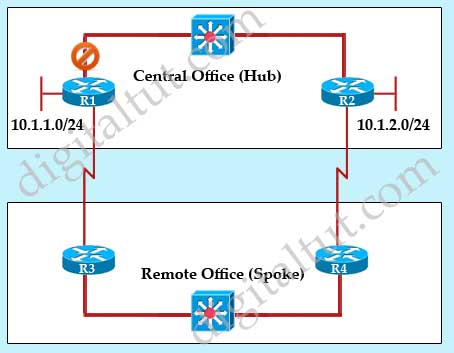
A. eigrp stub
B. eigrp stub receive-only
C. eigrp stub connected static
D. no eigrp stub connected static
E. No additional command is needed beyond a default EIGRP configuration.
Answer: B
Question 2
A network administrator is troubleshooting an EIGRP connection between RouterA, IP address 10.1.2.1, and RouterB, IP address 10.1.2.2. Given the debug output on RouterA, which two statements are true?
| RouterA#debug eigrp packets … 01:39:13: EIGRP: Received HELLO on Serial0/0 nbr 10.1.2.2 01:39:13: AS 100, Flags 0x0, Seq idbQ 0/0 iidbQ un/rely 0/0 peerQ un/rely 0/0 01:39:13: K-value mismatch |
A. RouterA received a hello packet with mismatched autonomous system numbers.
B. RouterA received a hello packet with mismatched hello timers.
C. RouterA received a hello packet with mismatched authentication parameters.
D. RouterA received a hello packet with mismatched metric-calculation mechanisms.
E. RouterA will form an adjacency with RouterB.
F. RouterA will not form an adjacency with RouterB.
Answer: D F
Question 3
Observe the exhibit. If the command variance 3 were added to RTE, which path or paths would be chosen to route traffic to network X?
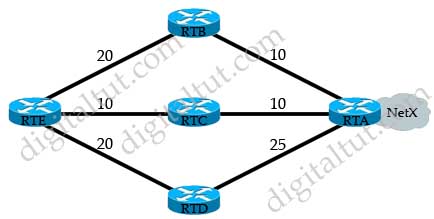
A. E-B-A
B. E-B-A and E-C-A
C. E-C-A and E-D-A
D. E-B-A, E-C-A and E-D-A
Answer: B
Explanation
Please notice that routes must first satisfy the feasible condition to be considered for “variance” command:
The feasible condition states:
“To qualify as a feasible successor, a router must have an AD less than the FD of the current successor route”.
In this case, the current successor route is E -> C -> A and the FD of this successor route is 20. But the AD of route E-D-A is 25 which is bigger than the FD of the successor route -> It will not be put into the routing table even if the “variance 3” command is used.
Question 4
Router E is configured with the EIGRP variance 2 command. What path will Router E take to reach Router A?

A. only E-D-A
B. only E-B-A
C. only E-C-A
D. both E-B-A and E-C-A
E. both E-B-A and E-D-A
F. all available paths.
Answer: D
Question 5
Refer to the exhibit. Which router configuration command can be given that will restrict router RTB from sharing its routing information with router RTA?
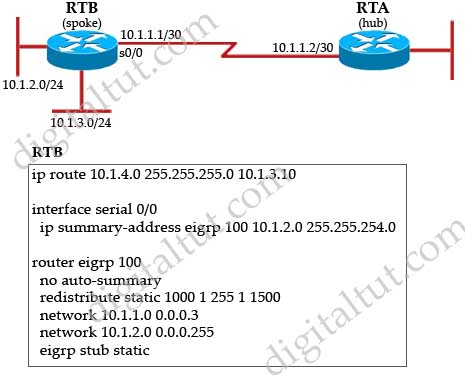
A. The eigrp stub command on router RTA.
B. The eigrp stub command on router RTB.
C. The eigrp stub connected command on router RTA
D. The eigrp stub connected command on router RTB
E. The eigrp stub receive-only command on router RTA
F. The eigrp stub receive-only command on router RTB
Answer: F
Explanation
The receive-only keyword will restrict the router from sharing any of its routes with any other router in that EIGRP autonomous system, and the receive-only keyword will not permit any other option to be specified because it prevents any type of route from being sent. The three other optional keywords (connected, static, and summary) can be used in any combination but cannot be used with the receive-only keyword.
(Reference: http://www.cisco.com/en/US/docs/ios/12_0s/feature/guide/eigrpstb.html)
Question 6
Refer to the exhibit. On all routers in the network, EIGRP has been configured for load balancing across the three links. However, traffic destined for Network B from R1 is only load balanced over paths R1-R2-R5 and R1-R3-R5. What is the cause of the problem?
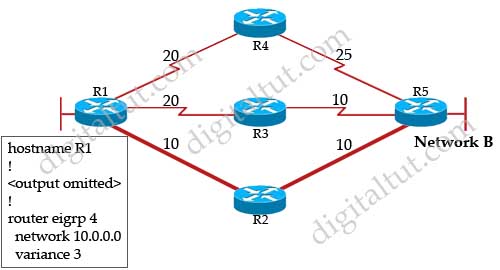
A. EIGRP will not select more than two links for unequal cost path load balancing.
B. Because the path has a different link type, EIGRP will not select path R1-R4-R5 for load balancing.
C. Because Router R4 is not a feasible successor, EIGRP will not select path R1-R4-R5 for load balancing.
D. EIGRP will not select path R1-R4-R5 for load balancing unless the value of the variance parameter is increased.
Answer: C
Explanation
The feasible condition states:
“To qualify as a feasible successor, a route must have an AD less than the FD of the current successor route”. In this case the AD of R4 is 25 (to network B, which is larger than the FD of the current successor R2 (its FD is 10 + 10 = 20) -> R4 is not a feasible successor.
Question 7
Refer to the exhibit. Which statement about dynamic routing protocols for this network is true?
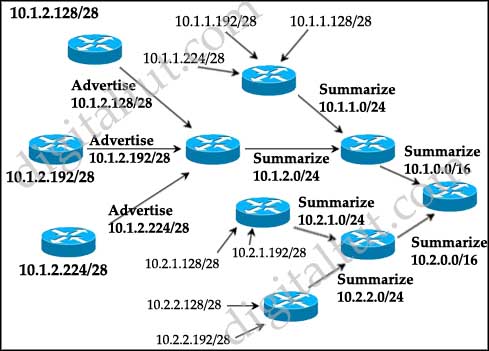
A. No dynamic interior routing protocol can summarize as shown.
B. Unless configured otherwise, EIGRP would automatically summarize the prefixes as shown in the exhibit.
C. With this IP addressing scheme, EIGRP can be manually configured to summarize prefixes at the specified summarization points.
D. The IP address design lends itself to OSPF. Each summarizing router would be an ABR, summarizing to the next area in the address hierarchy.
Answer: C
Question 8
Refer to the topology diagram R2 is redistributing the EIGRP routers into OSPF. What will the EIGRP routes appear in the routing table of R1?

A. O
B. O IA
C. O E2
D. D
E. D EX
Answer: C
Explanation
By default, routes redistributed into OSPF will be considered External route – Type 2 (E2) with the default metric of 20. For E2 route, the cost is only from the ASBR to the final destination.
Question 9
Refer to the Exhibit. Routers in the Diagram are configured with EIGRP. If RB and RC fail, which action will RA take with respect to the HQ network?
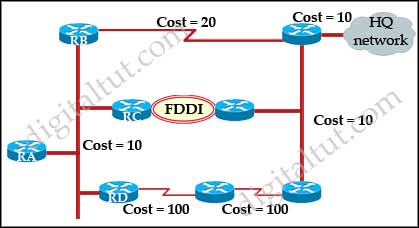
A. RA will automatically route packets via RD to the HQ network.
B. RA will place the route via RD into the hold down state.
C. RA will go into the active state for all routes.
D. RA will go into the active state for the route to HQ network.
Answer: D
Explanation
The cost advertised from RD is too big (100) so it cannot be a feasible successor -> RA will go to the active state if both RB and RC fail.



if you check the picture, some advertisements need to not be summarized from some of the routers on the left and others do. this can only be achieved with manual summarization